Delaware is a small state, but it contains an abundance of biodiversity and natural resources. One of the most interesting things about this area are the diverse types of mushrooms that can be found here.
From morel mushrooms to oyster mushrooms, Delaware’s mushroom population is incredibly varied.
Also common mushrooms in Delaware include chanterelles, oysters, giant puffballs, lion’s manes and turkey tails.
Whether you’re an amateur mushroom hunter or a seasoned enthusiast looking for something new to try, you’ll be pleasantly surprised by the array of mushrooms Delaware has to offer
List of Mushrooms in Delaware
1. Lion’s Mane
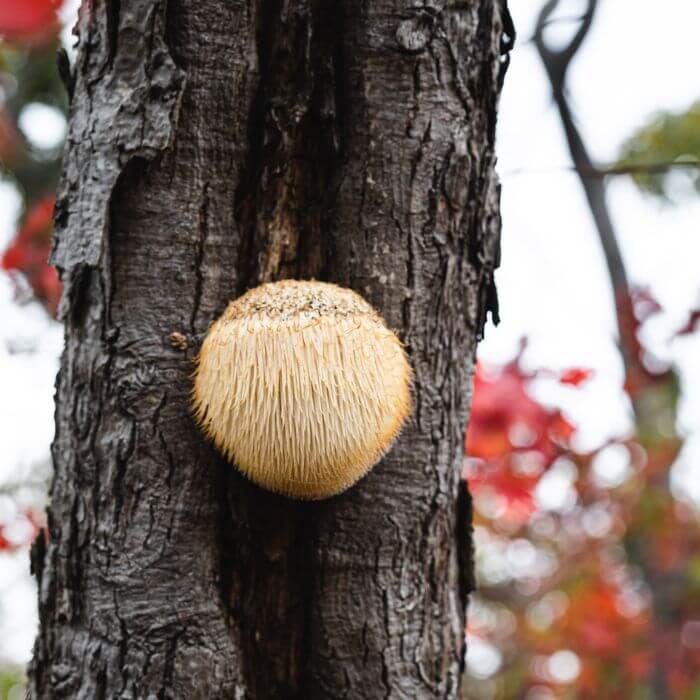
Lion’s mane mushrooms are white edible mushrooms that have been used in different cuisines for centuries.
It is also known by its scientific name Hericium erinaceus or its Japanese name Yamabushitake. The lion’s mane mushroom gets its distinctive shape from long white spines that hang down, making it look like the mane of a lion. It has a solid white color.
When can you find this hericium species? These white mushrooms of Delaware are found starting from late summer to early fall. Check around beech and oaks. Also, pick younger species; this means those that measure anywhere between 2-10 inches.
What does it taste like? Most foragers liken it to lobsters; so if you are allergic to seafood try this white mushroom. Note; lion’s mane takes longer to cook compared to other wild mushrooms such as morels.
2. Chanterelle
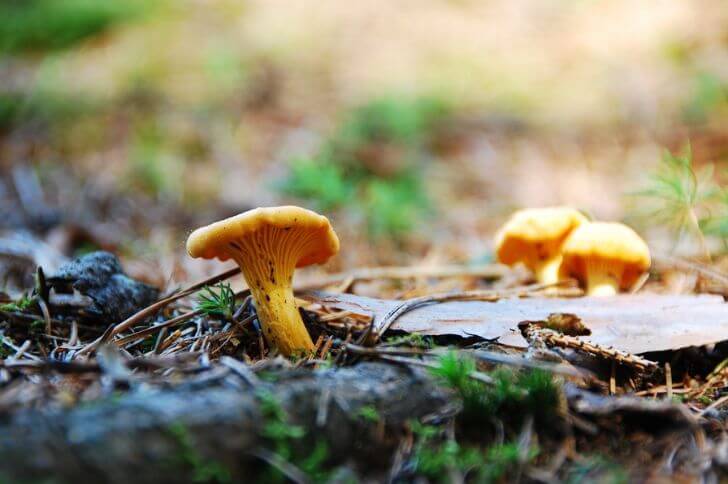
Here are the common chanterelles in Delaware:
Cantharellus cibarius: Also called golden chanterelle, this mushroom typically has a trumpet-shaped cap with wavy edges and a bright yellow color. The cap can range in size from less than an inch to several inches wide. The underside of the cap features gill-like ridges that are forked or blunt at the ends and run down the stem.
Cantharellus cinnabarinus: Also called the red chanterelle, is a type of edible red mushroom of Delaware that has a bright ruby-red hue that sets it apart from other yellow or orange chanterelles. Additionally, its cap is smooth and wavy with a vase-like shape.
Cantharellus chicagoensis: First discovered in Chicago, this chanterelle has spread eastwards up to Delaware. This rare and unique mushroom has attracted the attention of mycologists and mushroom enthusiasts alike.
Its cap shape is typically vase-like with wavy edges and ranges from yellow-orangish in color. The underside of the cap features ridges that are forked or blunt-edged, adding an additional identifier for this species.
Another important feature to note is the stem, which grows up to 3 inches tall and ranges from a light yellow color at its base to a darker orange hue towards the top.
3. Brick Caps
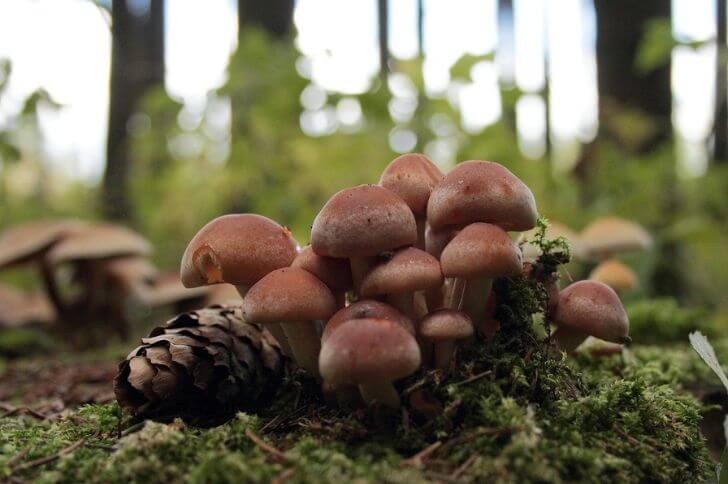
Brick caps are a fungus of many names. Local names are chestnut mushrooms, red woodlovers or cinnamon caps. In Japan they are kuritake.
Their most recognizable feature is their brick red cap. Its brick-reddish color ensures it stands out from the surrounding. Caps are convex but because they grow close to each other, they look distorted. Their margins are paler.
Underneath the cap lies white gills which often turn grayish as the mushroom matures. When identifying brick caps in the wild, look for them growing on decaying hardwoods during fall months.
These fall Delaware mushrooms are not often attacked by bugs but most foragers find them bitter. I would not recommend them, instead check out the oysters below.
Related read: check mushroom festivals near you
4. Oysters Mushrooms
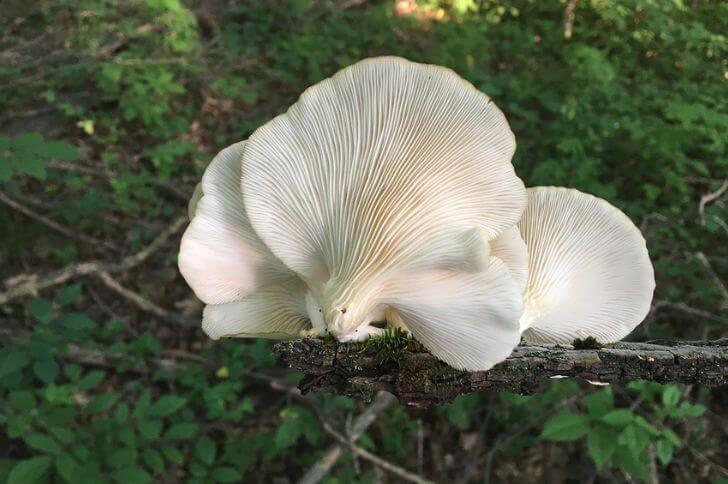
Aspen oysters: These mushrooms are highly sought after by foragers for their meaty texture.
To identify aspen oyster mushrooms in the wild, one should first look at their fan-like shapes with a smooth, velvety surface and white to cream-colored flesh.
The cap can range in color from light brown to grayish-brown, with a distinctive in-curved edge. Aspen oysters grow in clusters on dead or dying trees, often aspens.
Golden oysters: Also referred to as Pleurotus citrinopileatus, these mushrooms can be found growing wild or cultivated in Delaware. These mushrooms have a unique look, as they are yellowish to golden in color with a funnel-like cap shape and white gills underneath. Due to their mild flavor and texture, golden oysters have become popular among mushroom enthusiasts everywhere.
Blue oysters: These oysters have a strikingly vibrant hue that sets them apart from the rest. They also have a distinct fan-like shape with curved margins that resemble an oyster shell.Their mild, nutty flavor and delicate texture make them perfect for use in soups, stir-fries, salads, and more.
Where can you find blue oysters mushrooms in Delaware? This variety is cultivated. Get a grow kit.
5. Leucoagaricus Americanus
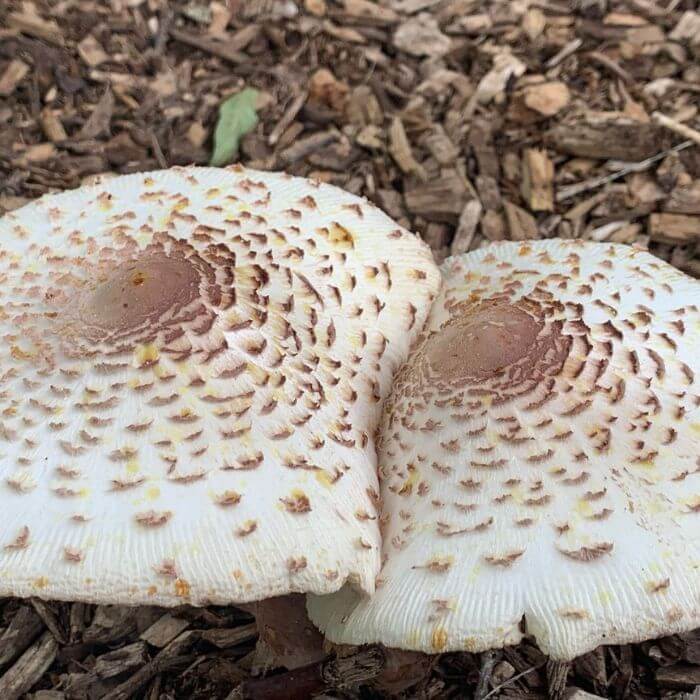
source:wildforflora
Native to eastern states, the leucoagaricus americanus is a pretty common Delaware mushroom that grows on wood chips, stumps, or saw dust.
Remember the dryad’s saddle on the list of mushrooms in Wisconsin? Leucoagraricus americanus have a similar look but different shape. Younger species have a more closed cap with less pronounced scales.
Mature mushrooms are about 3.9-4.7 inches wide with a brownish cap with darker scale. Notice, the cap is flatter with an umbo. Gills are short and crowded.
6. Megacollybia Rodmani
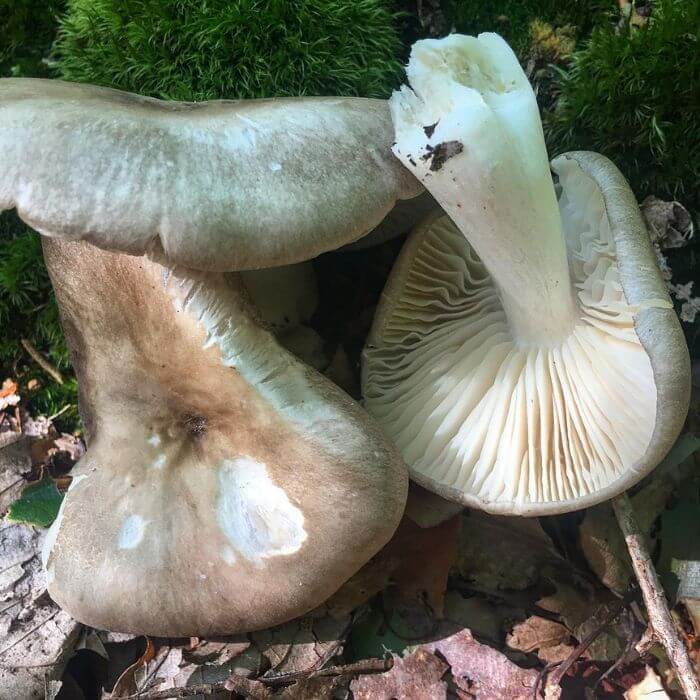
source: fascinatedbyfungi
Megacollybia rodmani is the first mushroom to pop out after the morel season in Delaware. After the first rains in May, you’ll notice them growing on rotting logs.
The Megacollybia rodmani has a gray or grayish-brown cap that is convex in shape when young but later flattens out as it matures. In full maturity, the margins turn upwards, giving it a funnel-like shape.
Its crowded gills are whitish as well as its flesh and as spore print. Check for these white mushrooms of Delaware from May to July.
7. Delaware Puffballs
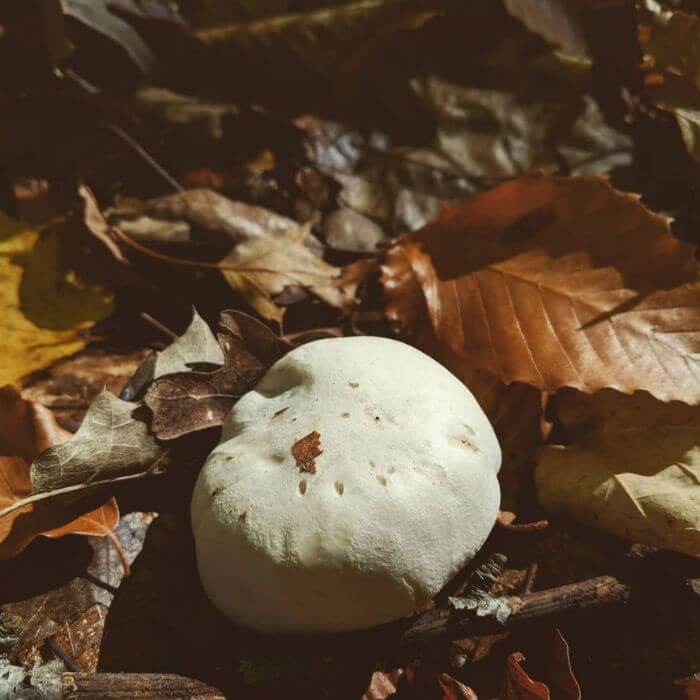
Common types of puffball mushrooms in Delaware include:
Calvatia cyathiformis: Also called the purple-spored puffball, it is a fungus that belongs to the family Agaricaceae. This purple Delaware mushroom is commonly found in fairly rings on pastures, lawns or golf courses.
Its cap can reach up to 8 inches in diameter, with a ball-shaped body. The fruiting body has a smooth and white surface that turns yellowish-brown as it ages.
When cut open, the interior of this mushroom is white and firm when young, eventually turning deep purple when spores mature.
Calvatia craniiformis: Also called the skull-shaped puffball or brain puffball, it is another puffball fungus found in Delaware. It gets its name from its shape, which resembles a human skull or brain. It’s common during the late summer to fall.
Calvatia Gigantea: The giant puffball mushroom can grow up to 3 feet in diameter and weighs around 15 pounds.
It has a round shape that resembles a ball with a smooth surface that ranges from white to brownish-gray color. The spores are released through small openings on the top of the mushroom when matured.
8. Lactarius Volemus (Weeping Milkcap)
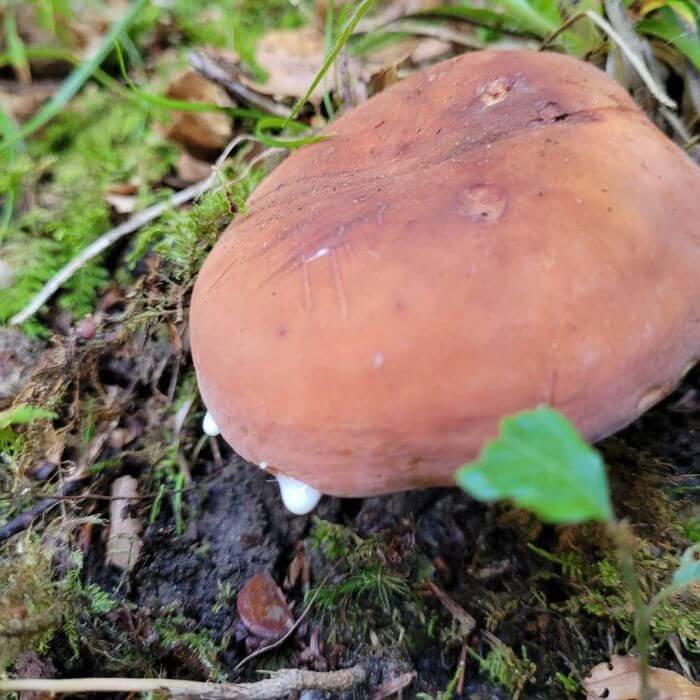
source: pilzverein_burgdorf_oberburg
Now to the foulest Delaware mushroom. Weeping milkcaps are attractive. They are good in photos but I wouldn’t recommend you harvest them.
These milkcaps have been categorized as choice edible. Their convex shaped cap grows to 4.5 inches wide with incurved margins and slight central depression. Young weeping milkcaps have a velvety texture.
With age, the margins stretch upwards, giving it a vase-like look. When sliced, these Delaware mushrooms have white flesh that stains brown.
They also produce a milky substance that stains everything brown. Your hands, the surface they are placed on, kitchen towels, they don’t spare anything.
Also, most foragers dislike their fishy smell. The pungent smell gets stronger the longer the mushrooms remain uncooked. Additionally their mild taste makes them unpalatable.
9. Chicken of the Woods
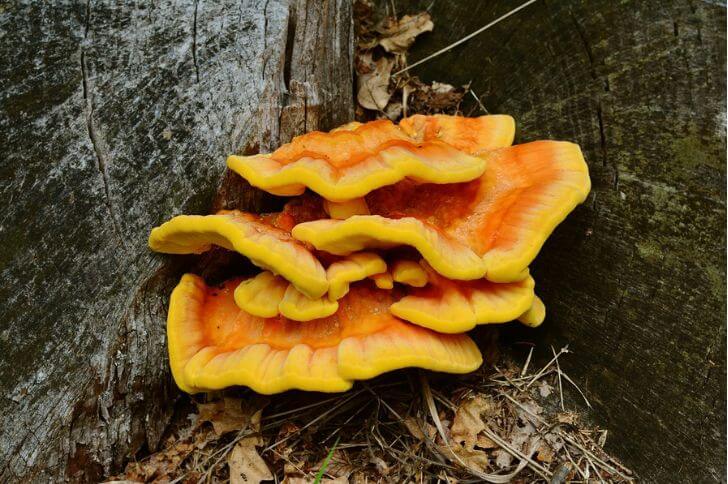
Another edible mushroom Delaware foragers hunt for is the chicken of the wood. Also called sulphur shelf, this bright orange-yellow mushroom is one of the most sought-after species, found during late summer and early fall.
Forage for them from August through November. They grow on trees; ensure what you harvest is growing on a deciduous tree, birches and oaks. Avoid those growing on eucalyptus and conifers.
When searching for a chicken of the woods, check for certain characteristics such as its orange-yellow coloration along with its fan or bracket shaped structure. Additionally look for pale yellow pores underneath and a white or yellowish spore print.
Should you eat chicken of the woods? Yes, you’ll definitely love its meaty taste. Also foragers are split about its taste; some describe it as chicken-like while others say it has a seafood (crab-like) taste.
10. Cortinarius Iodes (Viscid Violet Cort)
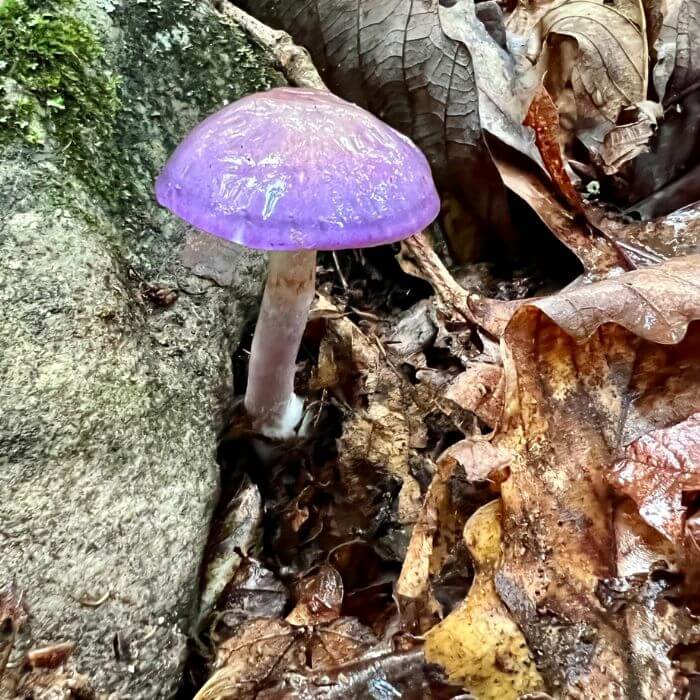
Cortinarius iodes, commonly known as the viscid violet cort, is a purple fungi species of The First State. With its distinctive lilac color and pale purple gills, the violet cort is both unique looking and easy to identify.
The cap of this small fungus has a diameter of 0.8-2.4 inches and usually takes on a bell shape becoming broader at maturity.
11. Morels in Delaware
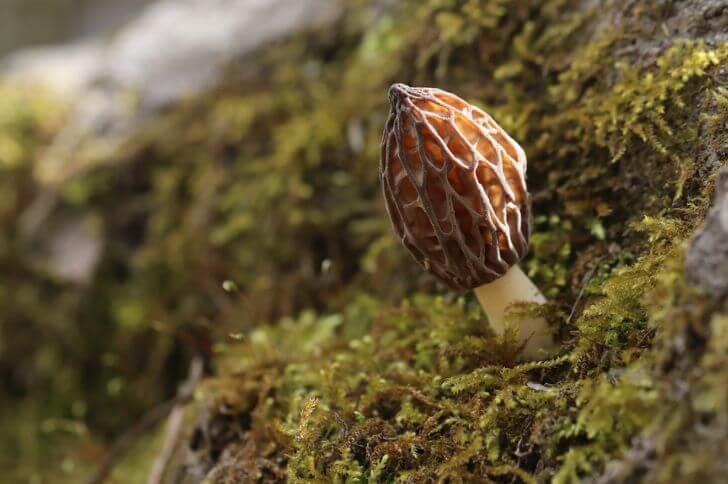
Morels are a popular and sought-after type of mushroom, renowned for their unique flavor and texture. Morels in DE include:
Gray morels: Identifying gray morels is essential if you plan on harvesting them for consumption or sale.
These mushrooms have a somewhat cone-shaped cap that is covered in small pits or depressions. The color of the cap can range from light gray to blackish, with darker shades being more common in older specimens.
The stem of the gray morel is typically whitish or pale yellow and has a hollow center. When hunting for gray morels, it’s important to keep an eye out for their preferred habitats; under beech, maples, and burnt meadows.
Black morels: The key feature to look out for when identifying black morels is their cap shape. Black morel caps have deep ridges that run from the top of the cap down to the stem.
The cap can range in color from dark brown to black, depending on how mature the mushroom is. Another distinguishing feature of black morels is their hollow stem – this helps differentiate them from false morels which have solid stems.
12. Gymnopilus luteus (Yellow Gymnopilus)
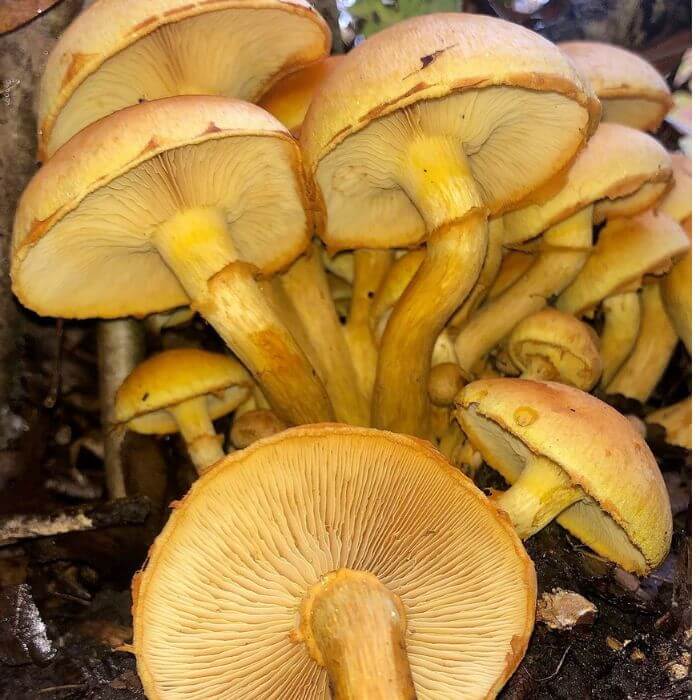
source: keara.giannotti
Gymnopilus luteus is a type of mushroom that belongs to the family Hymenogastraceae. It has an orange-yellow cap with yellowish gills and a club-shaped stem that can range from yellow to brown in color. The species is commonly found growing on decaying conifer wood.
Another identifying feature of the yellow gymnopilus is its spore print, which is rusty brown in color. This DE fungus is bitter.
13. Pluteus Aurantiorugosus (Flame Shield)
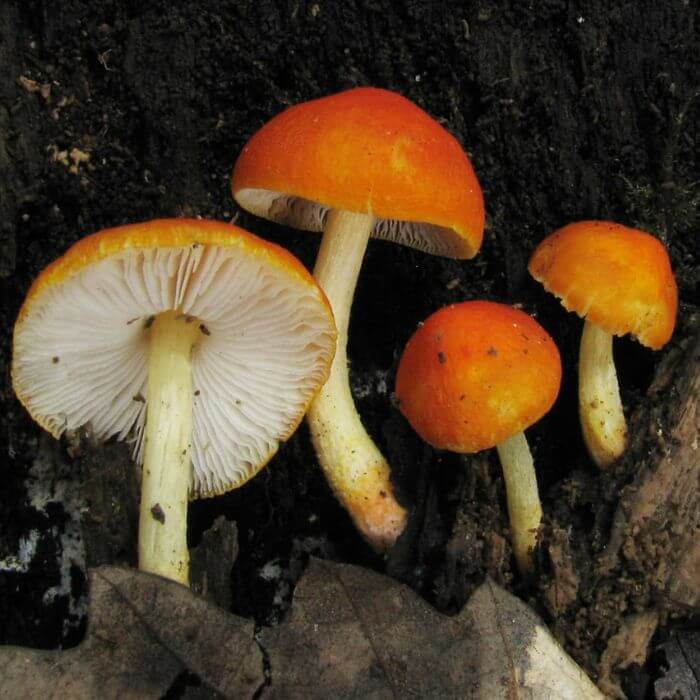
source:mykologia
Are there rare mushrooms in Delaware? Pluteus aurantiorugosus or flame shield mushrooms are rare.
They have a velvety convex, red cap with white gills underneath. Note the broad umbo. Its yellowish long stem has fine hair. They are considered inedible.
Final Thoughts:
In conclusion,the mushrooms of Delaware are a diverse and fascinating species that represent an important part of the state’s biodiversity.
Whether you’re looking for a tasty snack or simply want to appreciate their beauty, these fungi offer something for everyone. While the fungi of Delaware can be a bit difficult to identify, the list above will help you with identification.
Sources:
https://en.wikipedia.org/wiki/Calvatia_craniiformis
https://en.wikipedia.org/wiki/Cortinarius_iodes
Hi There,
My name is Jenny. I’m the Chief Editor at Try Green Recipes and besides making yummy and healthy foods for my kids, grandkids, and friends. I’m new to the blogging world but I believe what I have to share is unique and will bring joy to your home. If you are adventurous and want try something tasty, let’s get started.

